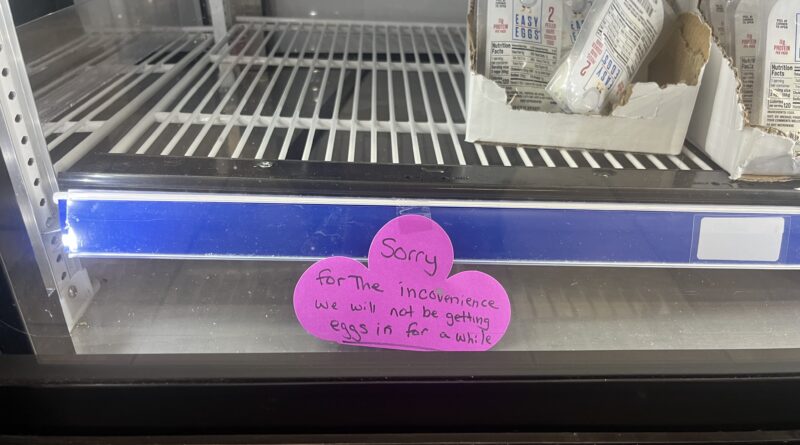Students Keeping Eggs in their Plates Despite High Prices
Tehron Spencer | Contributing Writer
Story Description: This story is about the rising cost of eggs and how it’s affecting both the student and dining services at the University of Dayton. Through interviews with 4 students and insights from the executive director of dining services Joan Bauman, the story explores the impact of egg inflation and potential solutions.
What was once considered a no-brainer has become a conscious purchase. What was once considered cheap has now become a flex to have. If you’re thinking about an old school, now rare car or wrist watch, you would be dead wrong.
It’s eggs.
Eggs have become a commodity of recent times. Shelves once stocked full with eggs now brandish signs limiting, or in the Emporium’s case, outright eliminating how many cartons a customer can buy. For University of Dayton students, the spike in egg prices has affected how they shop, eat and budget.
Egg prices have progressively risen the past two years, driven primarily by a nationwide outbreak of avian influenza. According to the Centers for Disease Control and Prevention, the bird flu has wiped out 166.4 million birds since February 2022, sharply reducing supply. Increased production costs, including higher feed and labor expenses, have added to the problem. As a result, the average price of a dozen eggs surged from about $1.93 in January 2022 to now $4.95 as of January 2025.
The impact of these rising costs is being felt across campus dining operations at UD. Joan Bauman, executive director of dining services, confirmed to Flyer News that UD recently introduced a 25-cent fee per egg for menu items containing whole or shelled eggs.
“Fortunately, the number of items affected is minimal,” Bauman said. “Egg sandwiches at Au Bon Pain and the Mongolian grill have seen the biggest impact. However, several of our items use pasteurized liquid eggs and frozen egg patties, which have not increased in price as much.”
While the dining fee adjustment aims to offset increased costs, students who buy their own groceries have also had to adjust their habits. Cameron Cope, a junior mechanical engineering major, said he’s noticed the price increase but hasn’t let it change his purchasing patterns yet.
“I buy eggs once a week,” he said. “The last time I went to the store, I saw a limit of two cartons per customer. That surprised me, but I still buy eggs because they’re a part of my daily diet.”
If prices continue to rise, Cope said he might switch to yogurt and toast for breakfast, but for now, shopping at Aldi helps him manage the cost.
Anna Pullman, a senior majoring in criminal justice, and Shannon McGinty, a senior marketing major, have both adjusted their buying habits in response to higher egg prices.
“I used to buy organic eggs like my mom always did,” Pullman said. “Now, I’m going for the cheaper white eggs.”
McGinty agreed, adding that while she hasn’t cut back on other groceries to afford eggs, she’s more conscious of how much she’s spending.
“I shop at Costco, so buying in bulk helps offset some of the cost increases,” she said.
Ty Stilski, a senior entrepreneurship major, admitted that he’s been buying more eggs recently despite the price spike.
“They’re an easy meal,” he said. “I usually cook eggs after working out because they’re quick and filling.”
Dan Kowaleski, a senior chemical engineering major, also relies on eggs as a staple source of protein.
“Even at four or five dollars a dozen, it’s still a cheap meal,” he said. “Unless it costs a dollar per egg, I’ll probably keep buying them.”
Jeremy Jonozzo, a senior accounting major, has become more price-conscious overall.
“Grocery prices have gone up across the board, not just eggs,” he said. “I’ve started paying closer attention to what I’m spending, but I haven’t cut eggs out of my budget yet.”
The students’ responses reflect a similar trend: While rising egg prices have been noticeable, most students are adapting rather than cutting eggs out entirely. UD Dining Services is taking a similar approach, hoping that the spike in egg prices will ease by the start of the next school year.
“We try to anticipate inflation when setting menu prices over the summer,” Bauman said. “This egg situation is more impactful than expected, but we hope to ride it out.”
For now, eggs remain a staple food for many UD students, even as costs rise. Whether shopping at Aldi, switching to cheaper eggs, or adjusting their overall grocery budget, most students have found a way to keep eggs on their plates. Or at least until prices climb too high to ignore.
REPORTER’S NOTE: In this story, AI was used to help with grammar and spelling. AI/tools were used to fact-check and to ensure the news content met the basic standards of accuracy/ethics.

